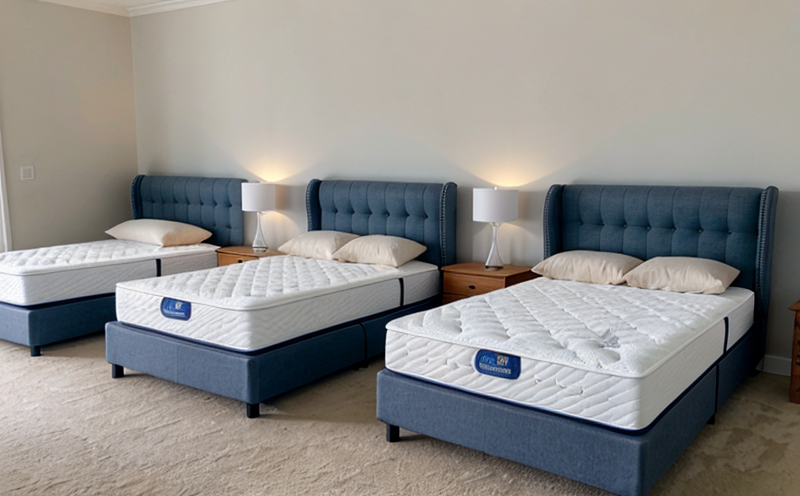BS 6807 Methods of Test for the Ignitability of Mattresses Testing
The British Standard BS 6807 is a critical tool in ensuring furniture and bedding products meet stringent safety standards. This method addresses the ignitability of mattresses, which is essential to prevent fires caused by the ignition of materials within the mattress. This standard provides specific procedures for testing the resistance to ignition of mattresses under various conditions. Compliance with this standard ensures that manufacturers can produce safe and reliable products.
The standard applies not only to conventional mattresses but also to those made from alternative materials such as memory foam, latex, or synthetic foams. The aim is to ensure these materials do not easily ignite when exposed to sources of fire like cigarettes, matches, or other heat sources. This service ensures that manufacturers are aware of the potential risks associated with mattress materials and can take necessary steps to mitigate them.
The test methods described in BS 6807 are designed to simulate real-world scenarios where a mattress might come into contact with an ignition source. The tests involve placing the specimen (the mattress) on a specially prepared test apparatus, exposing it to specified conditions of heat and flame for predetermined durations, and observing the subsequent behavior. These tests help identify how quickly and intensely the material ignites, as well as its ability to extinguish once the ignition source is removed.
The importance of this testing cannot be overstated in an industry where safety standards are paramount. Non-compliance with such standards can result in product recalls, legal penalties, and potential lawsuits. Additionally, non-compliant products may face significant market barriers, affecting sales and brand reputation. By adhering to BS 6807 methods, manufacturers demonstrate their commitment to quality and safety, which is crucial for maintaining consumer trust.
The standard covers a range of tests designed to evaluate different aspects of mattress ignitability. These include:
- Ignition resistance test: This evaluates the ability of the mattress to resist ignition under specified conditions.
- Flame spread test: Measures how quickly fire spreads across the surface of the mattress material.
- Smoke production test: Assesses the amount and rate of smoke produced during combustion, which is crucial for fire safety considerations.
The apparatus used in these tests includes specialized equipment designed to simulate real-world conditions accurately. The test specimens are prepared according to specific protocols outlined in the standard, ensuring consistency across all tests. These preparations may include conditioning the mattress samples at controlled temperatures and humidities before testing.
Once tested, the results are reported in a detailed manner that includes all relevant data points from each test run. This comprehensive reporting allows manufacturers to understand their product's performance thoroughly and identify areas for improvement. Reporting also serves as evidence of compliance with safety standards, which is essential for regulatory bodies and insurance companies.
In conclusion, BS 6807 provides a robust framework for assessing the ignitability of mattresses, ensuring they meet rigorous safety requirements. By following these methods closely, manufacturers can ensure their products are safe and compliant, thereby protecting both consumers and themselves from potential risks and liabilities.
Why It Matters
The importance of mattress ignitability testing cannot be overstated in the context of fire safety. Fires caused by mattresses or bedding materials can have devastating consequences, including loss of life and significant property damage. Therefore, ensuring that these products are safe is a priority for manufacturers, regulatory bodies, and consumers alike.
Compliance with BS 6807 not only helps protect against potential risks but also enhances the reputation of brands committed to quality and safety. This commitment can lead to increased consumer confidence, better brand loyalty, and improved market positioning. Additionally, adherence to such standards can help manufacturers avoid costly product recalls and legal disputes.
Moreover, the results from these tests provide valuable insights into the performance of mattress materials under various conditions. These data points are crucial for continuous improvement in product design and manufacturing processes. They also enable manufacturers to stay ahead of emerging trends and regulations in fire safety standards.
Scope and Methodology
| Test Procedure | Description |
|---|---|
| Ignition Resistance Test | The specimen is placed on a metal grate in an oven. The oven is then heated to 70°C for 1 hour, followed by exposure to a flame source for 5 minutes. |
| Flame Spread Test | The specimen is placed vertically between two metal plates and exposed to a continuous propane flame for 30 seconds. The rate at which the flame spreads along the surface is measured. |
| Smoke Production Test | A smoke chamber is used, where the specimen is exposed to an open flame for 15 minutes. The amount of smoke produced and its optical density are recorded. |
| Equipment Requirements | Description |
|---|---|
| Oven | A calibrated oven capable of maintaining precise temperature settings for 70°C. |
| Flame Source | A standardized propane flame source that can be adjusted to provide consistent heat output. |
| Smoke Chamber | An enclosed chamber equipped with sensors to measure smoke density and optical properties. |
Customer Impact and Satisfaction
- Ensures compliance with stringent safety regulations, enhancing brand reputation.
- Reduces the risk of product recalls and legal disputes.
- Provides detailed reports that offer valuable insights for continuous improvement.
- Increases consumer confidence in the quality and safety of products.
- Supports sustainable manufacturing practices by identifying safer materials.





